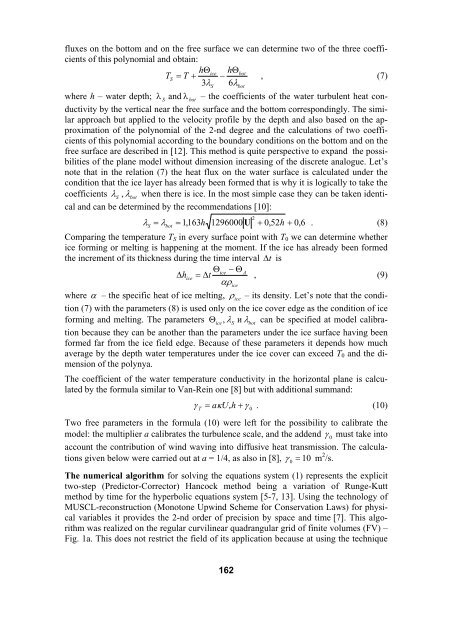You also want an ePaper? Increase the reach of your titles
YUMPU automatically turns print PDFs into web optimized ePapers that Google loves.
fluxes on the bottom and on the free surface we can determine two of the three coefficients<br />
of this polynomial and obtain:<br />
hΘice<br />
hΘbot<br />
TS<br />
= T + − , (7)<br />
3λ 6λ<br />
S<br />
where h – water depth; λ<br />
S<br />
and λ bot<br />
– the coefficients of the water turbulent heat conductivity<br />
by the vertical near the free surface and the bottom correspondingly. The similar<br />
approach but applied to the velocity profile by the depth and also based on the approximation<br />
of the polynomial of the 2-nd degree and the calculations of two coefficients<br />
of this polynomial according to the boundary conditions on the bottom and on the<br />
free surface are described in [12]. This method is quite perspective to expand the possibilities<br />
of the plane model without dimension increasing of the discrete analogue. Let’s<br />
note that in the relation (7) the heat flux on the water surface is calculated under the<br />
condition that the ice layer has already been formed that is why it is logically to take the<br />
coefficients λ<br />
S<br />
, λ bot<br />
when there is ice. In the most simple case they can be taken identical<br />
and can be determined by the recommendations [10]:<br />
bot<br />
2<br />
λ = λ = 1,163h<br />
1296000 U + 0,52h<br />
+ 0,6 . (8)<br />
S<br />
bot<br />
Comparing the temperature T S in every surface point with T 0 we can determine whether<br />
ice forming or melting is happening at the moment. If the ice has already been formed<br />
the increment of its thickness during the time interval ∆ t is<br />
Θice<br />
− ΘA<br />
∆ h ice<br />
= ∆t<br />
, (9)<br />
αρ<br />
where α – the specific heat of ice melting, ρ<br />
ice<br />
– its density. Let’s note that the condition<br />
(7) with the parameters (8) is used only on the ice cover edge as the condition of ice<br />
forming and melting. The parameters Θ<br />
ice,<br />
λ<br />
S<br />
и λbot<br />
can be specified at model calibration<br />
because they can be another than the parameters under the ice surface having been<br />
formed far from the ice field edge. Because of these parameters it depends how much<br />
average by the depth water temperatures under the ice cover can exceed T 0 and the dimension<br />
of the polynya.<br />
The coefficient of the water temperature conductivity in the horizontal plane is calculated<br />
by the formula similar to Van-Rein one [8] but with additional summand:<br />
ice<br />
γ = aκU<br />
h +<br />
T *<br />
γ 0<br />
. (10)<br />
Two free parameters in the formula (10) were left for the possibility to calibrate the<br />
model: the multiplier a calibrates the turbulence scale, and the addend γ<br />
0<br />
must take into<br />
account the contribution of wind waving into diffusive heat transmission. The calculations<br />
given below were carried out at a = 1/4, as also in [8], γ 10 m 2 /s.<br />
The numerical algorithm for solving the equations system (1) represents the explicit<br />
two-step (Predictor-Corrector) Hancock method being a variation of Runge-Kutt<br />
method by time for the hyperbolic equations system [5-7, 13]. Using the technology of<br />
MUSCL-reconstruction (Monotone Upwind Scheme for Conservation Laws) for physical<br />
variables it provides the 2-nd order of precision by space and time [7]. This algorithm<br />
was realized on the regular curvilinear quadrangular grid of finite volumes (FV) –<br />
Fig. 1a. This does not restrict the field of its application because at using the technique<br />
0<br />
=<br />
162

















